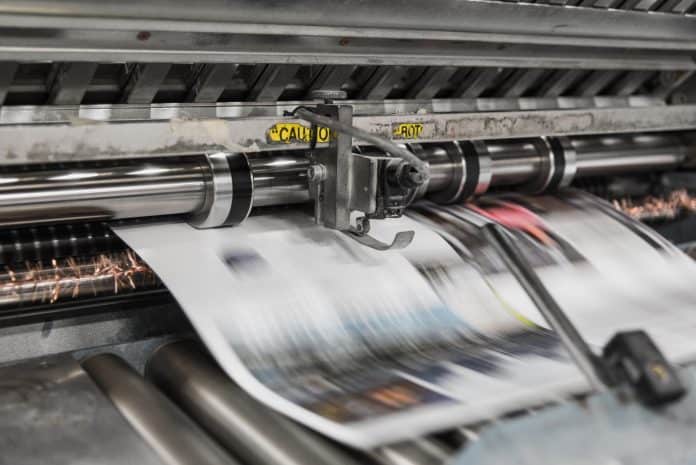Last updated on November 15th, 2021 at 01:42 pm
Printing goes back a long time, to roughly 3000 BC and even earlier to be exact. It has been an essential part of the growth and development of civilization over the years, proving to play an integral role in spreading culture. Printing didn’t always look the way it does now though. Back when printing was first put to use, the Mesapotamians used round cylinder seals for rolling an impress of images onto clay tablets. These days, you can purchase handheld devices that will instantly print the photos off your phone. We have come a long way in terms of how we document and replicate things, but let’s take a look at the history of printing and how we got to where we are today
When was the printing press invented?
No one actually knows when the first printing press was invented or who invented it, but we do know that the oldest known printed text was found in China during the first millennium A.D. The Diamond Sutra, a book from Dunhuang, China circa 868 A.D. is believed to be the oldest known printed book. This book was created with the block printing method, which used panels of hand-carved wood blocks in reverse. This period of time saw several printed materials, such as a printed calendar from roughly 877 A.D., vocabulary guides, math charts, dictionaries and more. The wood block printing method was utilized by both Japan and Korea around this period of time as well. It was also during this time that metal block printing was developed.

The history of printing and its evolution
Moveable type
Around 1041, Bi Sheng, from Yingshan, Hubei, China developed moveable type which replaced printing blocks with reusable individual letters. It is said that Bi Sheng did not use wood because the texture was inconsistent and absorbs moisture too easily. Before moveable type, lettering had to be written out in full. This technique allowed for individual letters to be configured and placed together in any order.
In 1297, woodtype appeared again when Wang Chen, Ching-te magistrate, printed a treatise on agriculture and farming practices called Nung Shu. This is considered the world’s first mass-produced book.
The printing press
Moving forward to 1440, Johann Gutenberg brings us the most innovative printing method to date. Arguably the most important person in the history and evolution of print, Gutenberg is behind the invention of the Printing Press. By combining techniques such as moveable type into a single device that could be operated by hand, Gutenberg rapidly sped up the process of producing printed materials, resulting in printed texts becoming widely available and were no longer restricted to just the wealthy. This helped improve the lifestyle of the lower class immensely, as people now had access to all of this information and education they hadn’t before. The first book to be mass produced was The Gutenberg Bible in 1455.
Etching – the Middle Ages
Around 1515, the method of etching was used to decorate metal arms and armour. This method was applied to printmaking by German craftsman, Daniel Hopfer. The etching process involves creating prints from a metal plate, typically copper or zinc. The plate is coated in an acid-resistant substance often referred to as Etching Ground, before it is drawn on, or etched, with a sharp tool. The plate is then placed in the acid, which removes the areas not protected by the Etching Ground. This creates recessed lines that hold the ink. The plate is then placed on paper and sent through a press to create the print.
Lithography
Fast forward to 1796, when the lithography technique that is still used today was born. Lithography centers around the relationship between water and oil, which repel one another. Using an oil based medium, such as a wax crayon, an image is drawn onto limestone. Then the stone is covered in a solution of Gum Arabic. The solution is then removed using lithographic turpentine which allows the ink to take only where it’s wanted.
The Rotary Press
In 1843, Richard March Hoe invented the Rotary Press. The Rotary Press worked using cylinders that the images to be printed were curved around. This was significantly faster than the printing press as it allowed for paper to be continuously fed through the press.
Offset printing
Offset printing is another technique that is still used today. Invented in 1875, this technique works by transferring the ink from a plate to a rubber blanket and then to the printing surface. Offset printing was born from the lithography technique, which is still used in some cases of fine art printmaking. These days, offset printing is one of the most common methods used to produce newspapers, magazines, books and other commercial materials due to its speed and consistency printing large quantities.
Screen printing
Screen printing was invented in China back between 960-1279 A.D., but did not take off until the early 1900’s. This is when silk stock became more available. The screen printing technique involves pushing ink through a mesh stencil onto textiles or paper. Screen printing is a popular method for t-shirt printing.
Inkjet printing
Inkjet printing allows for the ink to be sprayed through jets as opposed to direct contact with paper and is the most common type of printer. This method can recreate a digital image by spraying droplets of ink onto paper and plastic materials. The Inkjet method was first developed in the 1950s by Ichiro Endo, who worked at Canon. Around the same time, Jon Vaught from HP was working on a similar idea. These days, Inkjet printers are widely produced by Epson, Hewlett-Packard (HP), and Canon.
Laser printing
Inkjet printing paved the way for a whole new world of printing. Laser printing was quick to follow in 1969. An advanced method to produce high quality images by passing a laser beam back and forth over a negatively charged cylinder within the printer. Then it collects electrically charged powder ink to transfer the image to the paper.
Digital printing
In 1991, printing became something you could do in your own home with your own printer. Digital printing made it possible to print straight from a digital file in your home. Digital files, such as PDFs, can be sent directly to the digital printer which will print your file on paper, photo paper, etc.
While it is convenient to be able to print at home whenever you want, you don’t achieve the quality you would from a professional print service that utilizes methods such as offset printing or screen printing. Printing through a professional print service will guarantee quality and consistency. Your digital printer may not be able to color match the way you want, resulting in your prints looking different than you anticipated. Avoid this issue, among others, by leaving your professional print job to Printivity.
Explore all of your printing and contact Printivity today!

Shop Saddle Stitch Booklets at Printivity 
Shop Folders at Printivity 
Shop Postcards at Printivity




